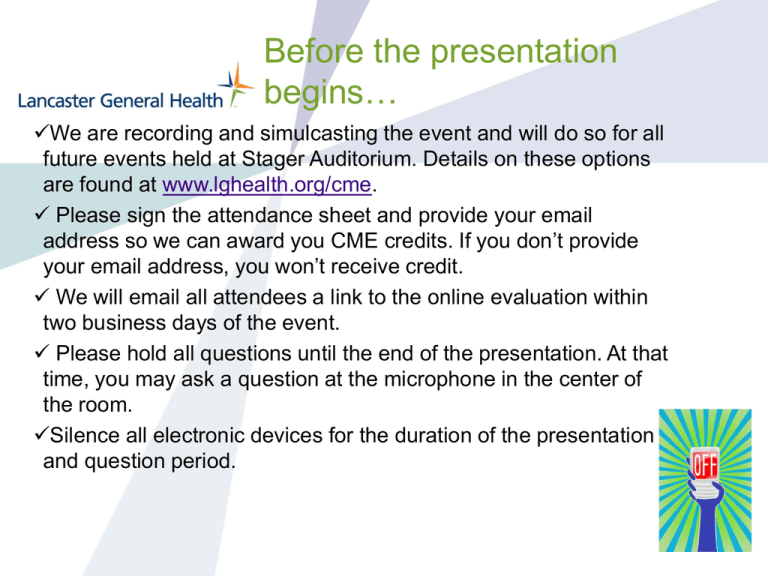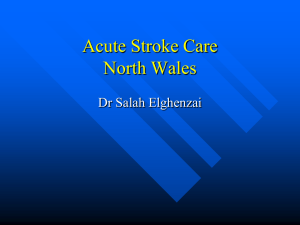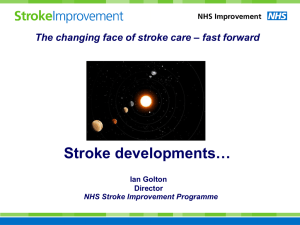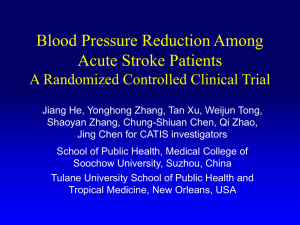
Before the presentation
begins…
We are recording and simulcasting the event and will do so for all
future events held at Stager Auditorium. Details on these options
are found at www.lghealth.org/cme.
Please sign the attendance sheet and provide your email
address so we can award you CME credits. If you don’t provide
your email address, you won’t receive credit.
We will email all attendees a link to the online evaluation within
two business days of the event.
Please hold all questions until the end of the presentation. At that
time, you may ask a question at the microphone in the center of
the room.
Silence all electronic devices for the duration of the presentation
and question period.
Welcome to Family Medicine Grand Rounds’ series:
Recognition and Acute Management of Stroke
This program includes a video, test and evaluation modules. After viewing the video, you
will be asked to complete a five question test and a brief evaluation in order to be eligible
for your CME credits. The estimated time to complete this entire activity is 1 hour and 15
minutes.
This program requires:
Windows
Microsoft Windows 2008 (required Desktop experience), Windows 7, Windows Vista, Windows XP, Windows 2003
Microsoft Internet Explorer 7.0 or later, Firefox 3.6 or later or Google Chrome
Windows Media Player 9.0 or later
Media Silverlight 5.0 or later
Broadband internet connection
MAC
MAC OS X 10.57 or later
Safari 4.0 or later or Firefox 3.6 or later
Microsoft Silverlight 5.0 or later (viewers are prompted to install this when attempting to view a presentation)
Broadband internet connection (256 Kbps or more)
Welcome to Family Medicine Grand Rounds’ series:
New Oral Anticoagulants: Are they better than what
we have?
Heather Harle, MD
Attending Neurologist, Neurology Associates of Lancaster
Recorded Wednesday, September 17, 2013.
This program will be available for CMEs until
September 17, 2015.
Objectives
Following the completion of this program, participants should be able
to:
1) Classify the clinical symptoms consistent with acute ischemic and
hemorrhagic strokes
2) Recognize basic radiologic (CT and MRI) findings consistent with
ischemic and hemorrhagic strokes
3) Assess localization of stroke, in particular signs/symptoms
associated with lacunar versus large vessel stroke.
4) Compare situations in which TPA would be considered to be used,
either IV or through neurointervention, and general exclusions to its
use.
5) Review basic in-hospital management of acute ischemic and
hemorrhagic stroke
Disclosure: None of the faculty/planners have revealed any
significant commercial interests that may bias his/her
presentation.
Accreditation Statement
The Lancaster General Hospital is accredited by the Pennsylvania Medical Society to
provide continuing medical education for physicians.
Designation Statement
The Lancaster General Hospital designates this live activity for a maximum of 1 AMA PRA
Category 1 Credit(s)™. Physicians should only claim credit commensurate with extent of
their participation in the activity.
Conflict of Interest Statement
Faculty and all others who have the ability to control content of continuing medical
education activities sponsored by Lancaster General Hospital are expected to disclose to
the audience whether they do or do not have any real or apparent conflict(s) of interest or
other relationships related to the content of their presentation(s).
Heather Harle, MD
September 17, 2013
ISCHEMIC
(85%)
HEMORRHAGIC
(15%)
Probability of dying much higher with
hemorrhagic
30 day mortality for ischemic is 7.6% vs. 37.5% for
hemorrhagic
Risk factor profile quite different between the
two
Ischemic – diabetes, a fib, previous stroke or MI,
PVD
Hemorrhagic – smoking, alcohol
Age, sex, hypertension does not predict stroke type
TIA - Brief episode of neurologic dysfunction
caused by focal retinal or brain ischemia, with
clinical symptoms lasting usually less than one
hour, and no evidence of acute infarction
Albers et al, NEJM, 2002.
STROKE – Neurologic dysfunction caused by
focal retinal or brain ischemia with symptoms
longer than 1 hour or evidence of acute
infarction on MRI.
Sudden onset of symptoms referrable to the
brain
Since the brain is topographically organized,
ischemic strokes fall into a discrete pattern of
syndromes primarily including some
combination of Aphasia, neglect, face/arm/leg
weakness or numbness, dysarthria, diplopia,
dysphagia, vertigo, gait changes.
ACA – leg
weakness,
apathy, urinary
incontinence
MCA – face,
arm +/- leg
weakness,
aphasia or
neglect,
hemianopsia
PCA –
hemianopsia,
memory loss
Lipohyalinosis of small
blood vessels of brain
(microvascular disease)
Thalamus, basal
ganglia, pons,
cerebellum
Smoking, hypertension,
hyperlipidemia,
diabetes are major risk
factors
December 5, 1913 –
April 12, 2012
Lacunar syndromes Pure motor, pure
sensory, sensorimotor,
ataxic hemiparesis
Tissue plasminogen activator is a naturally
occurring enzyme, that breaks plasminogen
into plasmin, causing clot breakdown.
Costs about 1500 dollars/dose
Approved for MI, PE, and acute ischemic
stroke
NINDS , 624 pts were treated with TPA (0.9
mg/kg) vs. placebo within 3 hours
½ were treated within 90 minutes
Primary efficacy outcome was complete or near
complete recovery 3 months after stroke.
Favorable outcomes were achieved in 31 – 50%
of pts who were treated, compared with 20 to
38% given placebo.
Risk of bleeding with stroke is about 0.6%
without TPA, 6.4% if TPA is given
Odds ratio for good outcome if treated within
90 minutes – 2.11
If treated within 180 minutes-1.69.
In general, we say you are 30% more likely to
be functionally independent at 3 months if
you receive TPA
TPA, approved in 1996, is now standard of
care, you technically don’t need to get consent
Inclusion
Clear time of onset (within 3 hours)
Symptoms consistent with stroke (acute onset, localizing
to a vascular territory. . .)
CT negative for blood, ischemic changes, unless early
Exclusion
0.9 mg/kg, 10% infused over 1 minute, the other
90% over 1 hr
BP’s less than 180/105 (labetalol pushes, nicardipine gtt)
Assess q 15 minutes during infusion, q30 minutes next 7
hours, and q1 hour next 16 hours
Stop infusion if there’s a clinical change for the worse
Platelets, cryoprecipitate if there’s a bleed
Admitted to Trauma neuro first 24 hours
Close monitoring and blood pressure control
No aspirin, DVT proph for 24 hours
Watch for neurological decline which could
signify hemorrhage
821 pts, Age 18-80, were randomized to
received IV- TPA 3 -4.5 hours
Excluding NIHSS >25
Excluding combination of diabetes and
previous stroke
52.4% vs. 45.2% had a favorable outcome
(Rankin 0-1 at 3 months); odds of a favorable
outcome 1.28.
The risk of bleeding goes up (27% vs 17%), but
risk of death the same between groups
Select patient who look like they’re having a
stroke from a clot in a large artery but who
aren’t a candidate for IV-TPA (ie. Are outside
the 3 hour, (or 4.5 hr) time window, may be a
candidate for IA-TPA.
Not done currently at LGH, we would ship
these patients to Hershey or Jefferson
PROACT II – 474 pts between 3 and 6 hours post
stroke underwent angiogram. 180 pts were
randomized to receive IV- prourokinase.
90 day mortality rates were the same (25 treated
and 27% control)
ICH was seen more commonly in the treated pts,
35% vs 13%. 10% were symptomatic
40% of treated pt vs 25% control pts had a Rankin
score of 2 or less at 90 days. NNT=7
Results extended to TPA as that’s the equivalent
available in the US.
This is the only trial actually showing that intraarterial approach is better than aspirin alone.
Every other trial looking at
devices uses “recanalization”
as the primary end point, not
actual patient improvement
MERCI - 151 pts enrolled ,
primary outcome measures
were recanalization- which
was 46% with device vs. 18%
control and good Rankin
score (<2) at 90 days – 46%
vs. 10%
Symptomatic ICH in 7.8%
(less than PROACTII)
Wire mesh similar to
cardiac stents. Deployed
inside a clot where it
expands, then is retracted.
58% have good outcomes
compared to 33% with
MERCI
17% treated with Solitaire
died, compared to 38%
treated with MERCI
NEJM Feb 2013
118 patients were randomized within 8 hours
of large vessel stroke to received aspirin only,
or go on to intra-arterial therapy, embolectomy.
No difference in outcomes
We now await large randomized trials
evaluating the efficacy of intra-arterial therapy,
is the cost worth it?
So they don’t get IV-TPA, or intervention, now
what?
Aspirin
BP management
Admission and w/u to determine etiology (in
order to prevent another stroke)
Address risk factors to prevent another stroke
CAST and IST established the effectiveness of
aspirin for acute stroke
CAST used 160 mg, IST used 300 mg, both within 48
hours of onset, 40,000 pts.
Combined, they showed a reduction of 9 fewer
deaths or non-fatal strokes per 1000 treated patients,
NNT 111.
As of now, no large randomized trials evaluate
the usefulness of any other anti-platelet in
acute stroke.
Early
Current recommendations are not to lower the bp
for the first 24 hours if bp is less than 220/120.
Really we don’t have good data to support this
In the IV-TPA patient, we lower below 180/105 for
the first 24 hours, there is good data that sICH is
more common in the pts with higher bp’s.
If BP is less than 120 systolic, consider laying head of
bed flat, and administering saline
Late
Reduces risk of recurrence 30-40%
JNC-7 - <140 systolic or <130 with DM, CKD
Evaluation for cause in order to prevent
recurrence includes:
Brain and vessel imaging
Echo, possibly TEE
Fasting lipids, possibly A1c
Swallow screening
Modifiable risk factors
High blood pressure (risk increased 4x, treatment
reduces likelihood by 40%), smoking (double the
risk, stopping reduces risk in 2-4 years), high
cholesterol, atrial fibrillation, diabetes, excessive
alcohol, recreational drugs, obesity, physical
inactivity, carotid disease
Non-modifiable risk factors
Age, race, heredity, sex
Aspirin – reduces risk of recurrence by 30%
Coumadin (risk of stroke reduced from 5% to
1.5% / year)
Plavix, Aggrenox
Pradaxa, xarelto
Statin (zocor/simvastatin, lipitor/atorvastatin,
crestor etc) – reduces risk by ~30% (LDL goal
less than 100, or less than 70)
Randomized, blinded, placebo controlled trial in
China
5170 pts with recent tia or small stroke were
randomized to receive 300 mg loading dose of
plavix and 75 to 300 mg aspirin daily (or placebo in
place of plavix)
Outcome measure was stroke or death at 90 days
Plavix plus aspirin group – 8.2%
Aspirin group – 11.7%
Bleeds were no different (0.3%)
Currently recruiting
Placebo or Plavix loading dose of 600 mg,
within 12 hours of small stroke/TIA
With 50-325 mg of aspirin daily
Outcome measure is stroke/MI, death at 90
days
(spontaneous intracerebral
hemorrhage)
Not sdh,sah, epidurals
More frequently: headache, vomiting,
decreased level of consciousness, very high
blood pressures, progression of deficit
BP control stat - Acute management includes
labetalol, nicardipine gtt, systolic less than 150
(our practice here)
Reversal of anti-coagulants
Repeat imaging (including blood vessels), ie.
MRI/MRA of brain
If pt scanned early, less than 3 hours, 1/3 may
progress and have increase in hematoma size
of 1/3 or more
This is the biggest prognosticator for
morbidity/mortality
How to prevent growth
Reversal of anti-coagulants
BP control
Check Starnet – Physicians – Pharmacy –
choose the anti-coagulant to reverse
Warfarin = Vitamin K and FFP
Heparin (low molecular weight heparin)=
protamine
Pradaxa/xarelto – No real reversal agents,
consider Factor VIIa or aPCC
INTERACT, Chinese trial, 2008, 400 patients
randomized to bp’s lower than 140 by 6 hours in,
vs lower than 180. There was less hematoma
growth with aggressive bp reduction, and neuro
outcomes were equivalent
ATACH replicated this
INTERACT 2 – NEJM JUNE 2013 – ~700 pts with
aggressive bp reduction (<140) vs <180 – no
difference in death or severe disability but at 3
months patients aggressively treated had better
Rankin scores
ATACH 2 is pending
Neurosurgery
Consult for “infratentorial”
(Brainstem or cerebellar locations)
High risk for herniation, hydrocephalus
Intraventricular blood
High risk for hydrocephalus
Large lobar or basal ganglia bleed
Greater than 2 cm
Clinical worsening
AVM other malformation
Most due to hypertension related changes in
the blood vessels “Charcot aneurysms”
Basal ganglia
Thalamic
Pontine
Cerebellar
Elderly patients with dementia and lobar
hemorrhages may have a condition called
cerebral amyloid angiopathy which leads to
ischemic and hemorrhagic strokes and seizures
Atypical locations, pt with hx of dementia
Radiology.casereports.net
Amyloid angiopathy
Elderly patients with
recurrent TIA’s,
strokes, hemorrhages,
seizures, dementia
ALCOHOL, DRUG USE, HTN, SMOKING
Adams Harold P, et al. Guidelines for the Early Management of adults with ischemic
stroke, Stroke, 38; 2007.
Anderson, Craig et al. Intensive blood pressure reduction in acute intracerebral
hemorrhage trial (INTERACT), Lancet, May 2008.
Anderson, Craig et al. Rapid Blood Pressure Lowering in Patients with Acute
Intracerebral Hemorrhage (INTERACT2), NEJM, June 2013.
Chinese Acute Stroke Trial (CAST). Randomized placebo controlled trial of aspirin use
in 20,000 pts with acute ischemic stroke, Lancet, 349:1997.
Furlan Anthony, et al. Intra-arterial Prourokinase for Acute Ischemic stroke, JAMA, 282;
21, 1999.
Gubitz G et al. Anticoagulants for acute ischemic stroke, Cochrane Database Syst Rev, 2;
2000.
Hacke, Werner et al. Thrombolysis with alteplase 3 to 4.5 hours after acute ischemic
stroke (ECAS III), NEJM 359;13, 2008.
International Stroke Trial Collaborative Group (IST), Lancet, 349; 1997.
Morganstern, Lewis et al. Guidelines for the management of spontaneous intracerebral
hemorrhage, Stroke 2010.
NINDS study group. TPA for acute ischemic stroke, NEJM, 333; 1995.
Qureshi, Al. Antihypertensive treatment of acute cerebral hemorrhage, (ATACH),
Neurocrit care, 2007, (6) 56-66.
Smith, Wade S, et al. Safety and Efficacy of Mechanical Embolectomy in acute ischemic
stroke (MERCI), Stroke, 2005.
Wang, Yongjun et al. Clopidigrel with aspirin in acute minor ischemic stroke or TIA.
NEJM, July 4, 2013.
Dipyradimole plus aspirin was shown in ESPS 2 and
Esprit to be better than aspirin alone for secondary
prevention.
Multiple European trials previous to these failed to
show benefit of the combination
JASAP and PROFESS failed to show noninferiority
to plavix.
Given that we have good evidence that plavix may
not be better than aspirin in patients with previous
stroke, my personal belief is it may not be better, and
certainly costs substantially more (and at least 25%
will discontinue due to headache).
Plavix does not actually reach maximum antiplatelet effect for 5 days. In ACS, a loading dose of
300 – 600 mg is given. In stroke, this has been
evaluated in a few small overseas trials, and was
shown safe.
CAPRIE showed plavix superior to aspirin in
preventing stroke, MI, or vascular death in patients
with PVD and MI, but not those with previous
stroke.
My practice, if a patient fails aspirin, may be to
switch to plavix, particularly if pt has PVD or hx of
MI
Aspirin plus plavix • The combination of aspirin and plavix in
three separate trials of secondary stroke
prevention (MATCH, CHARISMA, SPS III)
has been shown to lead to more hemorrhagic
complications with no reduction in recurrent
strokes
• However, CHANCE
• POINT is currently enrolling
Thank you for viewing the video. In order to receive your CME credit, please
click the “links” icon
at the bottom right hand side of your computer screen to take a post test
quiz and evaluation and receive your CME credits.
For technical questions about this program, please contact
rbolinger2@lghealth.org.
For questions about the content, please contact Dr. Harle at
hharle2@lghealth.org.







